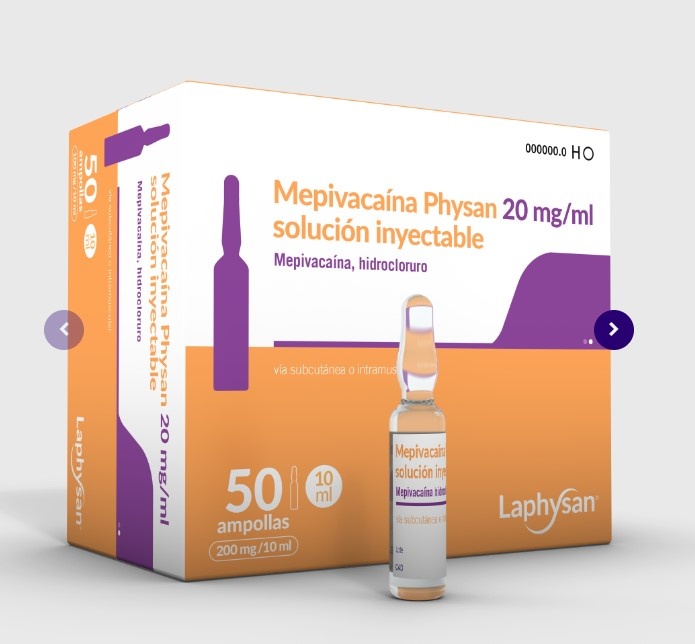

МЕПІВАКАЇН ФІЗАН 20 мг/мл РОЗЧИН ДЛЯ ІН'ЄКЦІЙ

Запитайте лікаря про рецепт на МЕПІВАКАЇН ФІЗАН 20 мг/мл РОЗЧИН ДЛЯ ІН'ЄКЦІЙ

Інструкція із застосування МЕПІВАКАЇН ФІЗАН 20 мг/мл РОЗЧИН ДЛЯ ІН'ЄКЦІЙ
Вступ
Опис: інформація для користувача
Мепівакаїн Фізан20 мг/мл ін'єкційний розчин
мепівакаїн гідрохлорид
Прочитайте уважно весь опис перед тим, як почати використовувати препарат, оскільки він містить важливу інформацію для вас.
- Збережіть цей опис, оскільки вам може знадобитися знову його прочитати.
- Якщо у вас є якісь питання, проконсультуйтеся з вашим лікарем або фармацевтом.
- Цей препарат призначений тільки для вас, і не передавайте його іншим людям, навіть якщо вони мають相同ні симптоми, оскільки це може їм нашкодити.
- Якщо ви відчуваєте побічні ефекти, проконсультуйтеся з вашим лікарем або фармацевтом, навіть якщо це побічні ефекти, які не вказані в цьому описі. Див. розділ 4.
Зміст опису:
- Що таке Мепівакаїн Фізан і для чого він використовується
- Що вам потрібно знати перед тим, як почати використовувати Мепівакаїн
- Як використовувати Мепівакаїн Фізан
- Можливі побічні ефекти
- Зберігання Мепівакаїну Фізан
- Зміст упаковки та додаткова інформація
1. Що таке Мепівакаїн Фізан і для чого він використовується
Мепівакаїн Фізан - місцевий анестетик (засіб, який зменшує або усуває відчуття, впливаючи на певну область) з підгрупи амідів.
Мепівакаїн Фізан призначений для надання вам анестезійного ефекту.
2. Що вам потрібно знати перед тим, як почати використовувати Мепівакаїн Фізан
Не використовуйтеМепівакаїн Фізан
- якщо ви алергічні на мепівакаїн гідрохлорид або на інші компоненти цього препарату (перелічені в розділі 6).
- якщо ви алергічні на інші місцеві анестетики з тієї ж групи (наприклад, бупівакаїн, лідокаїн).
- якщо у вас є порушення серцевого ритму. Проконсультуйтеся з вашим лікарем, оскільки Мепівакаїн Фізан може бути не рекомендований для вас.
- якщо у вас є не контрольована епілепсія.
- якщо у вас є гостра інтермітуюча порфірія (генетичне захворювання метаболізму, яке впливає на нервову систему і може викликати психічні розлади).
Попередження та застереження
Проконсультуйтеся з вашим лікарем або фармацевтом перед тим, як почати використовувати Мепівакаїн Фізан
- якщо у вас є серцеві захворювання.
- якщо у вас є важкі захворювання печінки.
- якщо у вас є захворювання нирок.
- якщо ви слабкий або літній пацієнт.
- Для спортсменів існує можливість позитивних результатів антидопінгових тестів.
Інші препарати та Мепівакаїн Фізан
Повідомте вашого лікаря або фармацевта, якщо ви використовуєте, нещодавно використовували або можете використовувати інші препарати.
Мепівакаїн Фізан повинен бути використаний з обережністю, якщо ви приймаєте лікування препаратами з подібною структурою до місцевих анестетиків, наприклад, препаратами для лікування порушень серцевого ритму (так звані антиаритмічні препарати класу Ib, наприклад лідокаїн), оскільки це збільшує ризик побічних ефектів.
Тривале лікування антиаритмічними препаратами (препаратами для контролю серцевого ритму), психофармакологічними препаратами (препаратами, які впливають на психічну діяльність) або антиконвульсантами (препаратами проти конвульсій) може зменшити чутливість до анестетиків.
Ви повинні бути обережні, якщо приймаєте препарати, які депресують центральну нервову систему, оскільки вони можуть збільшити депресивні ефекти.
Можлива місцеве подразнення, набряк або набухання, коли використовується одночасно з певними дезінфікуючими засобами.
Інгібітори згортання крові (препарати для запобігання згортанню крові) та препарати проти запалення можуть збільшити ризик кровотечі.
ВикористанняМепівакаїну Фізанз алкоголем
Надмірне вживання алкоголю може зменшити чутливість до анестетиків.
Вагітність та лактація
Проконсультуйтеся з вашим лікарем або фармацевтом перед тим, як використовувати будь-який препарат.
Ваш лікар призначить Мепівакаїн Фізан, враховуючи потенційну користь для вашого дитини та ризик для неї.
Мепівакаїн Фізан виділяється в грудне молоко, але ризик того, що дитина відчує побічні ефекти, здається низьким, якщо дотримуватися рекомендованих доз.
Водіння транспортних засобів та використання машин
Використання Мепівакаїну Фізан може мати легкий ефект на психічні функції та може тимчасово змінювати рухові функції та координацію.
Мепівакаїн Фізанмістить натрій
Ампули по 2 мл:
Цей препарат містить менше 23 мг натрію (1 ммоль) на одиницю; тобто, він практично не містить натрію.
Ампули по 10 мл:
Цей препарат містить 28 мг натрію (основний компонент кухонної солі) в кожній одиниці. Це відповідає 1,4% від максимальної добової норми споживання натрію, рекомендованої для дорослих.
.
3. Як використовувати Мепівакаїн Фізан
Слідуйте точно інструкціям щодо введення Мепівакаїну Фізан, вказаним вашим лікарем. У разі сумнівів проконсультуйтеся з вашим лікарем або фармацевтом.
Мепівакаїн Фізан буде введений вашим лікарем у вигляді ін'єкції.
Доза, швидкість введення та тривалість лікування будуть змінюватися залежно від анестезійного процесу, який проводиться, області, яка повинна бути знеболювана, та ваги, стану та реакції пацієнта.
Якщо ви використовуєте більшеМепівакаїну Фізан, ніж потрібно
У разі передозування можуть виникнути побічні ефекти на серцево-судинній системі: зниження артеріального тиску та порушення серцевого ритму. Також можуть виникнути побічні ефекти на центральній нервовій системі: агітація, відчуття оніміння губ, язика та навколо рота, головокружіння, порушення зору та слуху та звук у вухах. Труднощі з мовленням, м'язова ригідність або спазми - це більш серйозні симптоми, які передують генералізованим конвульсіям.
Якщо з'являються ці ознаки токсичності, введення анестетика повинно бути негайно припинено.
У разі передозування або випадкового прийому препарату зверніться до Токсикологічної служби. Телефон 91 562 04 20.
Якщо у вас є якісь інші питання щодо використання цього продукту, зверніться до вашого лікаря або фармацевта.
4. Можливі побічні ефекти
Як і всі препарати, Мепівакаїн Фізан може викликати побічні ефекти, хоча не всі люди їх відчувають.
Рідкісні побічні ефекти (спостерігаються у 1-10 з 10 000 пацієнтів)
Алергічні реакції, включно з тяжкими реакціями (анafilактичний шок), які включають висип, труднощі з диханням та набряк язика та горла.
Порушення серцевої діяльності та інфаркт (у разі передозування).
Небо та конвульсії (у разі передозування).
Нейрологічні реакції, пов'язані з анестезійними техніками, незалежно від використовуваного анестетика.
Звіт про побічні ефекти
Якщо ви відчуваєте будь-які побічні ефекти, зверніться до вашого лікаря або фармацевта, навіть якщо це побічні ефекти, які не вказані в цьому описі. Ви також можете повідомити про них безпосередньо через Систему моніторингу лікарських засобів для людини: www.notificaram.es. Надсилаючи звіти про побічні ефекти, ви можете допомогти надати більше інформації про безпеку цього препарату.
.
5. Зберігання Мепівакаїну Фізан
Тримайте цей препарат поза досяжністю дітей.
Не потрібні особливі умови зберігання.
Не використовуйте Мепівакаїн Фізан після закінчення терміну придатності, вказаного на ампулі та картоні продукту. Термін придатності - останній день місяця, який вказано.
Невикористана розчин повинна бути видалена згідно з місцевими правилами.
Лікарські засоби не повинні бути викинуті у водопровідні труби або сміття. Спитайте у вашого фармацевта, як позбутися упаковок та лікарських засобів, які вам не потрібні. Таким чином ви допоможете захистити навколишнє середовище.
6. ДОДАТКОВА ІНФОРМАЦІЯ
СкладМепівакаїну Фізан
- Активний інгредієнт - Мепівакаїн гідрохлорид 20,0 мг/мл.
- Інші компоненти: хлорид натрію, гідроксид натрію (для регулювання pH) та вода для ін'єкційних препаратів.
Вигляд продукту та вміст упаковки
Мепівакаїн Фізан 20 мг/мл ін'єкційний розчин упакований в скляні ампули.
Комерційна упаковка - упаковка з 1 ампулою або клінічні упаковки з 50 або 100 скляних ампул по 2 мл або 10 мл.
Уповноважений на отримання дозволу на реалізацію
ЛАФІЗАН С.А.У.
Анаベル Сегура, 11, Будівля А, 4-й поверх, Вхід Д,
28108 Алькобендас (Мадрид)
Іспанія
Відповідальний за виробництво:
ЛАБОРАТОРІЇ БАСІ - ФАРМАЦЕВТИЧНА ПРОМИСЛОВІСТЬ, С.А.
Промислова зона Мануеля Лоуренсу Феррейри,
Номер 8, Номер 15 та Номер 16
3450-232 Мортагуа - Португалія
Дата останнього перегляду цього опису: Липень 2008
Детальна інформація про цей препарат доступна на сайті Іспанського агентства лікарських засобів та медичних продуктів (AEMPS) http://www.aemps.gob.es/
Ця інформація призначена лише для лікарів або фахівців галузі охорони здоров'я
Місцеві та регіональні анестезійні процедури, крім тих, які мають більш тривіальний характер, повинні завжди проводитися кваліфікованими фахівцями та в зонах з негайним доступом до апарату та лікарських засобів для реанімації. Спеціалісти повинні отримати відповідну підготовку для таких процедур та бути знайомі з діагностикою та лікуванням побічних ефектів, токсичності чи інших ускладнень.
Коли проводяться великі блокади, перед введенням анестетика повинна бути вставлена катетер.
Враховуючи це, а також анестезійну техніку та стан пацієнтів, які будуть отримувати лікування, введення препарату повинно проводитися згідно з вказаними рекомендаціями та вказівками, включеними до різних розділів характеристики продукції ("Посологія та форма введення"; "Попередження та спеціальні застереження"), тому необхідно звернутися до тексту характеристики для забезпечення правильного використання продукту.
Розчини повинні бути використані негайно після відкриття. Будь-яка залишкова частина розчину повинна бути видалена.
Несумісності
Починаючи з pH>6,5 існує ризик осадження. Ця характеристика повинна бути врахована при додаванні лужних розчинів, таких як карбонати.
.
- Країна реєстрації
- Діючі речовини
- Потрібен рецептТак
- Виробник
- Інформація є довідковою і не є медичною порадою. Перед прийомом будь-яких препаратів обов'язково проконсультуйтеся з лікарем. Oladoctor не несе відповідальності за медичні рішення, прийняті на основі цього контенту.
- Альтернативи до МЕПІВАКАЇН ФІЗАН 20 мг/мл РОЗЧИН ДЛЯ ІН'ЄКЦІЙФорма випуску: РОЗЧИН ДЛЯ ІН'ЄКЦІЙ, 54 мгДіючі речовини: mepivacaineВиробник: Laboratorios Clarben S.A.Потрібен рецептФорма випуску: РОЗЧИН ДЛЯ ІН'ЄКЦІЙ, 10 мг/млДіючі речовини: mepivacaineВиробник: B Braun Medical S.A.Потрібен рецептФорма випуску: РОЗЧИН ДЛЯ ІН'ЄКЦІЙ, 20 мг/млДіючі речовини: mepivacaineВиробник: B Braun Medical S.A.Потрібен рецепт
Аналоги МЕПІВАКАЇН ФІЗАН 20 мг/мл РОЗЧИН ДЛЯ ІН'ЄКЦІЙ в інших країнах
Найкращі аналоги з тією самою діючою речовиною та терапевтичним ефектом.
Аналог МЕПІВАКАЇН ФІЗАН 20 мг/мл РОЗЧИН ДЛЯ ІН'ЄКЦІЙ у Польща
Аналог МЕПІВАКАЇН ФІЗАН 20 мг/мл РОЗЧИН ДЛЯ ІН'ЄКЦІЙ у Україна
Лікарі онлайн щодо МЕПІВАКАЇН ФІЗАН 20 мг/мл РОЗЧИН ДЛЯ ІН'ЄКЦІЙ
Консультація щодо дозування, побічних ефектів, взаємодій, протипоказань та поновлення рецепта на МЕПІВАКАЇН ФІЗАН 20 мг/мл РОЗЧИН ДЛЯ ІН'ЄКЦІЙ – за рішенням лікаря та згідно з місцевими правилами.














